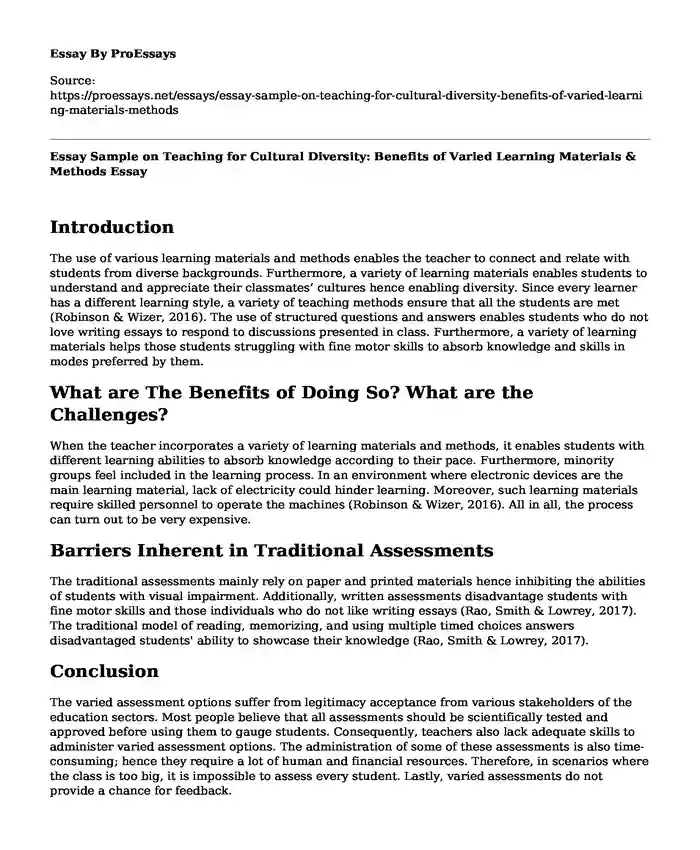Introduction
The use of various learning materials and methods enables the teacher to connect and relate with students from diverse backgrounds. Furthermore, a variety of learning materials enables students to understand and appreciate their classmates’ cultures hence enabling diversity. Since every learner has a different learning style, a variety of teaching methods ensure that all the students are met (Robinson & Wizer, 2016). The use of structured questions and answers enables students who do not love writing essays to respond to discussions presented in class. Furthermore, a variety of learning materials helps those students struggling with fine motor skills to absorb knowledge and skills in modes preferred by them.
What are The Benefits of Doing So? What are the Challenges?
When the teacher incorporates a variety of learning materials and methods, it enables students with different learning abilities to absorb knowledge according to their pace. Furthermore, minority groups feel included in the learning process. In an environment where electronic devices are the main learning material, lack of electricity could hinder learning. Moreover, such learning materials require skilled personnel to operate the machines (Robinson & Wizer, 2016). All in all, the process can turn out to be very expensive.
Barriers Inherent in Traditional Assessments
The traditional assessments mainly rely on paper and printed materials hence inhibiting the abilities of students with visual impairment. Additionally, written assessments disadvantage students with fine motor skills and those individuals who do not like writing essays (Rao, Smith & Lowrey, 2017). The traditional model of reading, memorizing, and using multiple timed choices answers disadvantaged students' ability to showcase their knowledge (Rao, Smith & Lowrey, 2017).
Conclusion
The varied assessment options suffer from legitimacy acceptance from various stakeholders of the education sectors. Most people believe that all assessments should be scientifically tested and approved before using them to gauge students. Consequently, teachers also lack adequate skills to administer varied assessment options. The administration of some of these assessments is also time-consuming; hence they require a lot of human and financial resources. Therefore, in scenarios where the class is too big, it is impossible to assess every student. Lastly, varied assessments do not provide a chance for feedback.
References
Rao, K., Smith, S. J., & Lowrey, K. A. (2017). UDL and intellectual disability: What do we know and where do we go? Intellectual and Developmental Disabilities, 55(1), 37-47. https://doi.org/10.1352/1934-9556-55.1.37
Robinson, D. E., & Wizer, D. R. (2016). Universal Design for Learning and the quality matters guidelines for the design and implementation of online learning events. International Journal of Technology in Teaching and Learning, 12(1), 17-32.
Cite this page
Essay Sample on Teaching for Cultural Diversity: Benefits of Varied Learning Materials & Methods. (2023, Sep 25). Retrieved from https://proessays.net/essays/essay-sample-on-teaching-for-cultural-diversity-benefits-of-varied-learning-materials-methods
If you are the original author of this essay and no longer wish to have it published on the ProEssays website, please click below to request its removal:
- Due Process of Student Suspension and Expulsion: Paper Example
- Promoting Health and Wellness in Children Essay
- Gorge Orwell's 1984 and Language Essay
- Essay Sample on Student Truancy
- Schooling in a Social Context: Educational Environments Essay
- Essay Example on American Art: Exploring Gender, Native American & Colonist Identity
- From West Africa to the US: Essay Sample on A Self-Analysis Journey of Life







